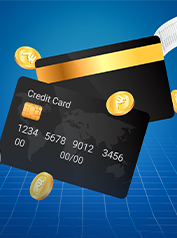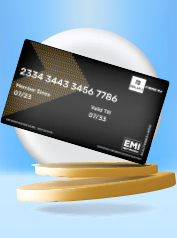Understand the meaning of an outstanding amount on a credit card and explore strategies to manage your payments effortlessly.
It is the total money you owe to the bank or credit card company. The outstanding amount on a credit card includes unpaid purchases, interest charges, fees, EMIs, interest on a cash advance and other transactions that remain unpaid.
This amount increases when you make new purchases or take cash advances. You have to pay it by the due date to avoid interest charges and late fees, which will be added if the balance remains unpaid.
Understanding how the outstanding amount and the statement balance differ helps you manage your payments and use your card more effectively. Here is a simple breakdown based on key parameters:
Aspects |
Outstanding Amount |
Statement Balance |
|---|---|---|
Meaning |
The total amount owed at present, including unpaid amounts from previous months and the amount from the transactions done after statement closing date |
The total of all transactions made during a billing cycle |
Timing |
Represents your financial status at a specific point in time, and changes with each transaction |
Reflects the financial status at the end of the billing cycle and remains unchanged until the next cycle |
Billing Cycle |
Not Applicable |
Covers a specific period between the statement’s opening and closing dates |
Accuracy |
Always up to date and adjusts with every transaction |
Fixed until the next billing cycle begins |
Decision Making |
Helps in making real-time decisions based on current liability |
Useful for assessing your financial status at the end of each billing cycle |
Interest Charges |
Interest applies when the outstanding amount is not paid in full by the due date |
Interest applies on the total amount on the card statement if the entire balance is not paid off by the due date |
Your credit card balance changes based on your spending and repayments. You can calculate the credit card’s outstanding amount in a simple way. It involves adding all recent credit card transactions and subtracting any payments you have made. Here is how you can do it in a step-by-step manner:
Start with your previous balance from the last billing cycle
Add all new purchases made using your credit card
Include any cash advances or balance transfers
Add interest charges, late fees, and other applicable charges
Subtract payments made and any refunds received to get the final amount
Calculation:
Say you have a balance of ₹8,000. During the month, you spent ₹4,500 on new purchases and repaid ₹2,000. Additionally, you incurred ₹150 in interest and ₹50 in fees.
Now, here is how your current outstanding balance is calculated:
Outstanding Balance = Starting Balance + Purchases - Payments + Interest + Fees
Outstanding Balance = ₹8,000 + ₹4,500 - ₹2,000 + ₹150 + ₹50
Outstanding Balance = ₹10,700
This way, your current outstanding balance is ₹10,700.
Monitoring your current outstanding balance is key to managing your finances effectively. It helps prevent overspending, avoids unnecessary fees, and supports maintaining a healthy credit score. Here is why is it crucial:
Prevents Overspending: Regular tracking ensures you stay within your credit limit, avoiding over-limit fees and financial stress
Better Expense Planning: Knowing your outstanding amount allows you to plan your spending wisely and stick to your budget
Avoids Late Fees and Interest: By keeping track of your balance, you can make timely payments and avoid costly late fees and high-interest charges
Helps Maintain a Good Credit Score: Maintaining a low balance and paying on time positively impacts your credit score
Reduces Unnecessary Debt: Staying informed on what you owe helps avoid piling up debt and keeps your financial health in check
Managing your credit card balance effectively can help you avoid debt, reduce interest charges, and maintain a strong credit score. Here are some straightforward tips to keep your balance under control:
Pay More Than the Minimum Due: Paying more than the minimum due reduces your balance faster and lowers the interest you pay
Tackle High-interest Balances First: Prioritise clearing balances of cards with the highest interest rates to reduce your financial burden more quickly
Enable Payment Reminders: Set alerts or reminders to stay on top of your due dates and avoid missing any payments
Pause New Credit Card Spending: Refrain from making new purchases on your card while focusing on clearing your current balance
Pay Through EMIs: If paying your bill in full is difficult, contact your bank to convert your outstanding balance into manageable EMIs
The outstanding amount on a credit card is the total money you owe, which includes:
Unpaid purchases
Interest charges
Fees
Previous balance
To calculate your current balance, follow these simple steps:
Start with your previous balance
Add new purchases, cash advances, balance transfers, interest, and fees
Subtract any payments or refunds
Yes, most issuers allow partial payments towards the outstanding balance. However, paying only a part of the total dues may lead to interest charges being levied on the remaining balance.
Paying the entire balance on your credit card statement helps you avoid interest charges and other penalties. It also helps maintain a healthy credit score and steer clear of accumulating debt since it prevents carrying any balance into the next billing cycle.
You can reduce or manage outstanding balance by incorporating the following tips:
Pay more than the minimum due
Prioritise paying off high-interest cards
Use balance transfers to cards with lower interest rates
Convert large bills into EMIs if your bank allows it
Avoid new purchases until you reduce the balance












